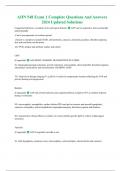AHN 548 Exam 1 Complete Questions And Answers
2024 Updated Solutions
Congenital infections- essentials of dx and typical features ANS can be acquired in utero, perinatally
and postnatally
-Can be asymptomatic in newborn period
-clinical sx complexes include IUGR, chorioretinitis, cataracts, cholestatic jaundice, thrombocytopenia,
skin rash and brain calcifications
-Dx: PCR, antigen and antibody studies and culture
CMV
(Congenital) ANS MOST COMMON TRANSMITTED IN UTERO
Sx: hepatosplenomegaly, petechiae, growth restriction, microcephaly, direct hyperbili, thrombocytopenia,
intracranial calcifications and chorioretinitis, HEARING LOSS
TX: Ganciclovir therapy 6mg/kg IV q12h for 6 weeks for symptomatic neonates affecting the CNS and
prevent hearing loss progression
Rubella
(Congenital) ANS risk of fetal infection and congenital defects as high as 85% in mothers infected
during 1st trimester.
SX: microcephaly, encephalitis, cardiac defects (PDA and pul art stenosis and arterial hypoplasia),
cataracts, retinopathy, and micropthalmia, hepatosplenomegaly, thrombocytopenia and deafness
Dx: characteristic clinical illness in mother, inc serum rubella-specific IgM or culture of pharyngeal
secretions
Varicella
(Congenital) ANS Congenital varicella is rare
Sx: limb hypoplasia, cutaneous scars, microcephaly, cortical atrophy, chorioretinitis and cataracts
,Perinatal caricella --> neonate should receive varicella-zoster immune globulin or IVIG, or if that's not
done --> acyclovir.
Toxoplasmosis
(congenital) ANS Most infants initially asymptomatic
Sx: mental retardation, visual impairment, learning disabilities, growth restriction, jaundize,
chorioretinitis, sz, hepatosplenomegaly, adenopathy, cataracts, maculopapular rash, thrombocytopenia,
pneumonia
Dx: positive toxoplasma-specific IgA, IgE, or IgM in first 6mo of life
Tx: spiramycin for mom to prevent transmission to fetus. Neonatal tx- pyrimethamine and sulfadiazine
with folinic acid.
Sources: cat feces, ingestion of raw/undercooked meat
Fetal damage most severe in 2-6th month gestation.
Parvovirus B19
(Congenital) ANS If infected during pregnancy- results in severe anemia, myocarditis, nonimmune
hydrops, or fetal death. If fetus survives, long term outcome is good.
Congenital syphilis ANS Active primary and secondary maternal syphilis leads to transplacental
passage to fetus in nearly 100% of cases.
Fetal infection can reult in stillbirth or prematurity.
Sx: mucocutaneous lesions, lymphadenopathy, hepatosplenomegaly, bony changes, hydrops (newborns
often asymptomatic)
Herpes Simplex
,(Perinatal) ANS acquired during transit through infected birth canal
Sx days 5-14: localized (skin, eye, mouth) or disseminated (shock, pneumonia, hepatitis) disease
Sx days 14-28: CNS- lethargy, fever, sz
Dx: viral cultures from vesicles, PCR
Tx: acyclovir 60mg/kg/d divided q8h- 14days if localized, 21 days if disseminated or CNS.
Mom needs c/s if active genital disease
If mom has active lesions at delivery, neonate needs eye, oropharynx, nasopharynx, rectum and blood
HSV PCr- if colonized, treatment with acyclovir x10days (if no active lesions on infant)
Hepatitis B & C
(Perinatal) ANS Infected at time of birth, intrauterine transmission rare
If mother haspositive HBsAg, then the infant should receive HBIG. and hep B vaccine asap after birth. If
mom not tested before birth, run test after, give Hep B vaccine within 12hours, and if pos, HBIG too.
Enterovirus infection
(Perinatal) ANS Pos maternal hx of diarrhea, fever and/or rash.
Sx: appears in first 2 weeks- fever, lethargy, irritability, diarrhea and/or rash. Can p/w
meningoencephalitis, myocarditis, hepatitis, pneumonia, shock and DIC
Dx: PCR
TX: no identified therapy, good prognosis except those with hepatitis, myocarditis or disseminated dz
HIV infection
, (Perinatal) ANS Can be acquired in utero at time of delivery or via breast milk
Known mothers with HIV should be treated with zidovudine therapy as early as 14weeks gestation. Infant
for first 6 weeks of life beginning within 12hours.
Best prevention combination: c/s, zidovudine and avoidance of breastfeeding.
Unknown mothers- prophylaxis with 2-3 rx.
Infants asymptomatic, test HIV DNA PCR at 48hrs, 2weeks, 1-2 months, and 2-4 months.
Vitamkin K deficiency bleeding in newborn ANS Frequently exclusively breastfed, otherwise
clinically well infant
Bleeding from mucous membranes, GI tract, skin or internal (intracranial)
Prolonged PT normal PTT normal fibrinogen and platelet count
Clotting factor deficiency (II, VII, IX, and X).
DDx: DIC and hepatic failure
Tx: 1mg vitamin K SC or IV. avoid IM if pt is actively bleeding
Thrombocytopenia ANS Generalized petechiae; oozing at cord or puncture sites
Thrombocytopenia (platelets usually <50,000/ml)
In an otherwise well infant, suspect isoimmune thrombocytopenia- mother's iGG antibody leads to
platelet destruction- may need to treat with IVIG to mom or infant.
Tx: transfuse platelets (10ml/kg increases platelet count by 70,000/ml), in preterm infants at r/f IVH,
transfuse for counts <40-50,000.




